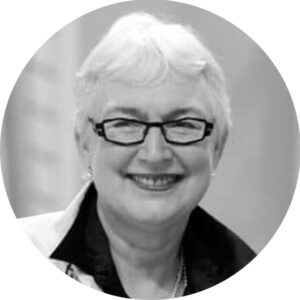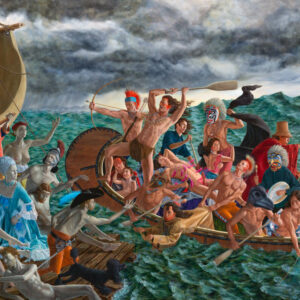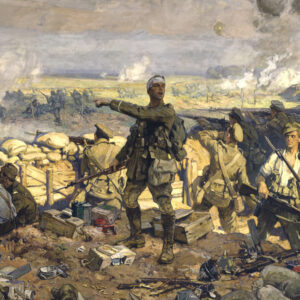-
MacCarthy, Hamilton (Canadian, 1846–1939)
A pioneer of early monumental bronze sculpture in Canada, MacCarthy studied sculpture under his father, Hamilton W. MacCarthy, and at the RA Schools in London. MacCarthy designed numerous Boer War memorials in Ottawa, Quebec City, Brantford, Halifax, Canning, and Charlottetown. Other major works include his statue of Samuel de Champlain, 1915, at Nepean Point, Ottawa, and the South African War Memorial, 1902, in Confederation Park, Ottawa. See artwork by this artist.
-
MacDonald, J.E.H. (British/Canadian, 1873–1932)
A painter, printmaker, calligrapher, teacher, poet, and designer, and a founding member of the Group of Seven. His sensitive treatment of the Canadian landscape was influenced by Walt Whitman’s poetry and Henry David Thoreau’s views on nature. See artwork by this artist.
-
MacDonnell, William (Canadian, b.1943)
Born in Winnipeg, MacDonnell is a painter who has participated in two Canadian Forces artist programs, one in Croatia in 1994 and the other in Afghanistan in 2007. He received his formal training at the University of Manitoba and at the Nova Scotia College of Art and Design University and subsequently taught at both institutions and the Alberta College of Art and Design (now the Alberta University of the Arts). See artwork by this artist.
-
MacKay, Allan Harding (Canadian, b.1944)
A multi-disciplinary artist, an arts administrator, and a member of the Royal Canadian Academy of Arts, MacKay has participated in two of the Canadian Forces artist programs, in 1993 and again in 2002. His experience as a war artist in Somalia (1993) was influential in his artistic career and his subsequent series Somalia Yellow includes award-winning film, photography, and drawing. MacKay has also included political commentary in his artwork and reflected in art on the symbolism of the Canadian landscape. See artwork by this artist.
-
MacLeod, Pegi Nicol (Canadian, 1904–1949)
A member of the Canadian Group of Painters, Nicol was a modernist painter whose work depicted energetic, vibrant scenes from the environments around her. She was known as Pegi Nicol MacLeod after 1937. See artwork by this artist.
-
Manet, Édouard (French, 1832–1883)
Considered a forerunner of the modernist movement in painting, Manet eschewed traditional subject matter for depictions of contemporary urban life that incorporated references to classic works. Although his work was critically dismissed, his unconventional painting style influenced the Impressionists.
-
Marsh Beveridge, Jane (Canadian, 1915–1998)
Born in Ottawa, Marsh Beveridge was a pioneering filmmaker for the National Film Board (NFB), after initially joining as a screenwriter in 1941. In 1941–42, she produced six films on the roles and experiences of women on the home front during the Second World War. After leaving the NFB in 1944 following a dispute with then-commissioner John Grierson, Marsh Beveridge moved to New York to work for British Information Services. Retiring from filmmaking in 1948, she continued her education and became a teacher and sculptor. See artwork by this artist.
-
May, (Henrietta) Mabel (Canadian, 1877–1971)
A modernist painter of landscapes, urban scenes, and portraits and figure paintings of women. May studied under William Brymner at the Art Association of Montreal, before spending time in Britain and France in 1912–13. After her return to Canada she was commissioned by the Canadian War Memorials Fund to depict women workers in munitions factories. May was an active member of Montreal’s Beaver Hall Group in the early 1920s and a founder of the Canadian Group of Painters in 1933. See artwork by this artist.
-
Mayerovitch, Harry “Mayo” (Canadian, 1910–2004)
An architect, artist, illustrator, author, and cartoonist, Mayerovitch was a graduate of the School of Architecture at McGill University and the artistic director of the Wartime Information Board’s Graphic Arts Division. From 1942 to 1944, Mayerovitch designed propaganda posters in support of Canadian wartime efforts during the Second World War. See artwork by this artist.
-
McKenzie, Robert Tait (Canadian, 1867–1938)
An educator, physician, surgeon, and sculptor, McKenzie was considered a pioneer in modern physiotherapy practices for his work developing rehabilitative methods for wounded soldiers during the First World War. He was a prominent sculptor during his lifetime, producing more than 200 works of art. See artwork by this artist.
-
Michelangelo (Italian, 1475–1564)
A sculptor, painter, architect, engineer, and poet during the High Renaissance, Michelangelo di Lodovico Buonarroti Simoni was renowned during his lifetime and is considered one of the greatest artists in history. His best-known works include the sculptures David, 1501–04, and Pietà, 1498–99, the frescoes in the Sistine Chapel, and his design for the dome of St. Peter’s Basilica, Rome. See artwork by this artist.
-
Milne, David (Canadian, 1882–1953)
A painter, printmaker, and illustrator whose work—principally landscapes—displays the tonal brilliance and concern with process of his Impressionist and Post-Impressionist influences. Milne lived in New York early in his career, where he trained at the Art Students League and participated in the Armory Show in 1913.
-
Monkman, Kent (Cree, b.1965)
A Toronto-based artist who is internationally recognized for his provocative works reinterpreting the canon of Western art history from an Indigenous perspective, Monkman was raised in Winnipeg and is a member of the Fisher River Band in northern Manitoba. He explores themes of colonization, sexuality, loss, and resilience in painting, film, video, performance, and installation, which often feature his gender-fluid alter ego Miss Chief Eagle Testickle. See artwork by this artist.
-
Morrice, James Wilson (Canadian, 1865–1924)
One of Canada’s first modernist painters and first artists to gain international recognition, during his lifetime Morrice was nonetheless more celebrated in Europe than he was at home. He is best known for richly coloured landscapes that show the influence of James McNeill Whistler and Post-Impressionism.
-
Morris, Edmund Montague (Canadian, 1871–1913)
A painter best known for his portraits of Indigenous leaders during Canada’s post-Confederation treaty negotiations, especially of the early twentieth century, although he was also an admired landscape painter. In 1906 Morris, on commission, accompanied the James Bay expedition for the negotiation of Treaty 9 with Cree and Ojibway peoples. He often used pastel in detailed, close-up portraits of Indigenous chiefs. With fellow painter Curtis Williamson, Morris instigated the creation of the Canadian Art Club in 1907, of which he was a key member. See artwork by this artist.
-
Mosher, Christopher Terry “Aislin” (Canadian, b.1942)
A political cartoonist for the Montreal Gazette drawing under the pen name “Aislin,” Mosher has created over 14,000 cartoons and is the author of fifty-one books. His work came to prominence during a period of major political and cultural change in Canada in the late 1960s, and his political cartoons have, at times, been considered irreverent. See artwork by this artist.
-
Mowat, Harold (Canadian, 1879–1949)
Known for his magazine illustrations, Mowat was an illustrator who served as an official Canadian war artist during the First World War. After training at the New York School of Art (now Parsons School of Design), Mowat created illustrations for magazines such as McCalls, Ladies’ Home Journal, and Saturday Evening Post. See artwork by this artist.
-
Muhlstock, Louis (Galician/Canadian, 1904–2001)
A painter and draftsman known for his sensitive and intimate representations of Depression-era Montreal. His celebrated talent for drawing comes through in his portraits, cityscapes, and interiors, which often show the effects of economic decline. He was made an Officer of the Order of Canada in 1991.
-
 About the Author
About the Author
Laura Brandon was the Historian, Art and War, at the Canadian War Museum from 1992 until 2015.
-
 More Online Art Books
More Online Art Books
Read online or download the ACI’s incredible library of art books for free in French and English.
Learn More -
 Read from Beginning
Read from Beginning
Throughout history, there have always been conflicts between different peoples and rival countries.
Learn More
